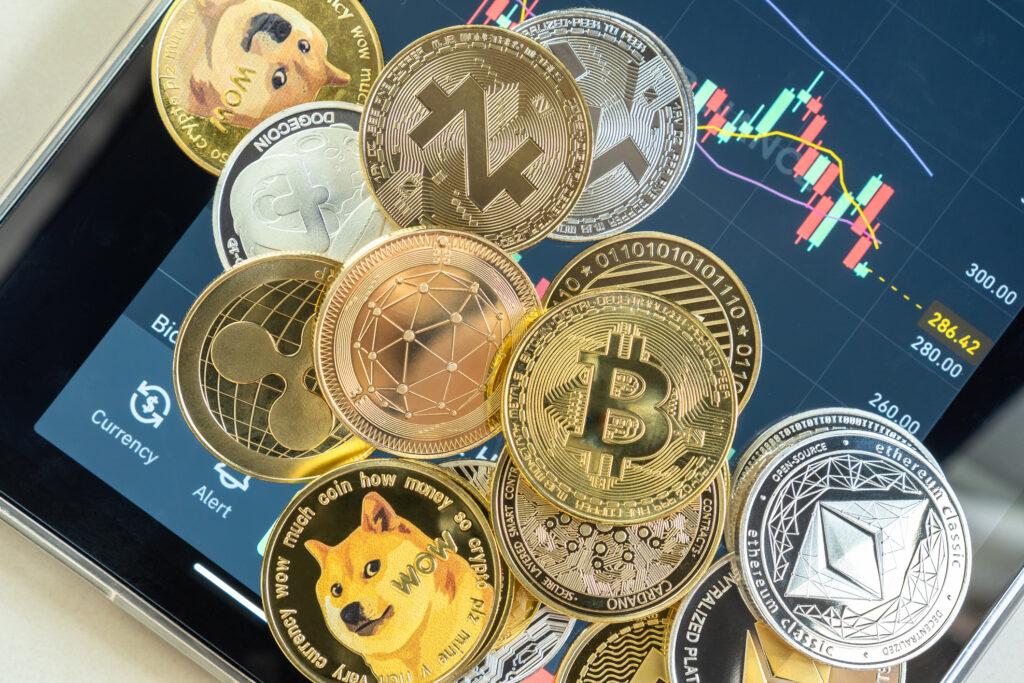If you are interested in investing in crypto, you need to know about the different types of cryptocurrencies that exist. However, before we dive into the various kinds of crypto, we should clarify the distinction between coins and tokens. In this article, we will explain what coins and tokens are, and how they differ from each other. We will also introduce some of the most popular and promising cryptocurrencies that you should be aware of.
Related Topics:

Difference Between Crypto Coins and Tokens
Coins are native to the blockchain they belong to, while tokens are built on top of another blockchain. For example, Bitcoin and Ether are coins that run on their own blockchains, while Uniswap and Chainlink are tokens that use the Ethereum blockchain. However, some people may use the terms coins and tokens interchangeably, so be aware of the context. There are many types of crypto, depending on their purpose and function. In this article, we will explore some of the most common and important ones.

Security Tokens Explained
Security tokens are a type of crypto that represent a financial asset that can be traded. To determine if an asset is a security or not, we can use the Howey-Test, which is based on the US Securities Act. According to this act, a security is something that involves investing money in a common project and expecting to make profits from the work of others. If this sounds confusing, don’t worry. We can break it down into some questions to ask ourselves:
- Was there an investment of money?
- Was the money invested in a common enterprise?
- Was there an expectation of profit?
- Are the profits solely from the efforts of the promoter or a third party?
You can find examples of security tokens by searching for STOs on websites like icoholder.com and coincodex.com. And in case you are wondering, Bitcoin does not qualify as a security token, because it does not involve a common project that relies on others’ work.

Types of Security Tokens
Security tokens can be classified into two categories: equity tokens and debt tokens. Equity tokens grant the holders some ownership rights over an asset or a company. For instance, “The Elephant Private Equity Coin” and “Recovery Right Token (RRT)” are examples of equity tokens.
Another type of security tokens is asset-backed tokens. These tokens represent the value of an underlying asset that can be traded. For example, paper money is a form of asset-backed tokens that is based on the value of gold. However, asset-backed tokens have a problem of trust. The issuer of the token can claim that the token is backed by anything, but without proper verification, this claim is not reliable.
Some examples of assets that can be tokenized are:
- Precious metals, such as gold. For example, PaxGold (PAXG) and Digix Gold Token (DGX) are tokens that are backed by gold.
- Company shares, which can be traded as crypto tokens instead of using traditional exchanges.
- Liquid commodities, such as oil and minerals. For example, The PetroDollar (XPD) claims to be backed by oil and mineral reserves.
- Real estate, which can be represented by crypto tokens in different countries. For example, The IHT Coin is a token that aims to tokenize real estate, but it seems to be incomplete.

Utility Tokens Explained
Unlike security tokens, which are traded for profit, utility tokens are traded for some use or benefit. For example, FIL (Filecoin) or SC (SIA) tokens can be used to store files, and CVC (Civic) tokens can be used to verify identities. In the real world, gift cards and public transportation tickets are similar to utility tokens. Some other utility tokens are the Basic Attention Token and the Golem Token.

Non-Fungible Tokens Explained
Most coins and tokens are fungible, which means they can be exchanged for each other. For example, you can use any one dollar note to buy a snack. But some things are unique and non-fungible, such as art, comics, stamps, or baseball cards. For example, each Van Gogh painting is different and valuable. CryptoKitties are the digital version of non-fungible collectibles. They are tokens that only you can own and enjoy. This concept is very appealing for computer games, where players already spend a lot of money on rare items. By using blockchain technology, players can have more control over their items and maybe even trade them across different games in the future. How cool would that be?

Stablecoins Explained
Stablecoins are digital tokens that mimic the value of fiat currencies. They can be classified into three types:
- Fiat-backed, which are backed by fiat currency reserves. For example, Tether (USDT) and Gemini Dollar (GUSD) are fiat-backed stablecoins.
- Crypto-backed, which are backed by another cryptocurrency as collateral. For example, DAI is a crypto-backed stablecoin.
- Algorithmic, which use a smart contract to adjust the supply and demand of the stablecoin to maintain a stable price. Some stablecoins are actually coins that have their own blockchain, such as TerraUSD and Steem Dollars. Others are tokens that run on another blockchain, such as Tether and USD Coin, which are ERC20 tokens on Ethereum.

Conclusion
To summarize, I suggest you study tokenomics to learn more about this topic. Also, before you invest in a crypto project, you should ask these questions:
- Is it a coin or a token? If it’s a token, what blockchain does it use? Does the project plan to switch from Ethereum to its own blockchain later? This can help you to know the security risks, the development challenges, and the impact of Ethereum’s gas fees on the project.
- What category does it belong to? Is it a digital currency, an exchange token, a smart contract blockchain, NFT, an asset-backed token, a utility token, or something else? This can affect the legal aspects and the value proposition of the project.



